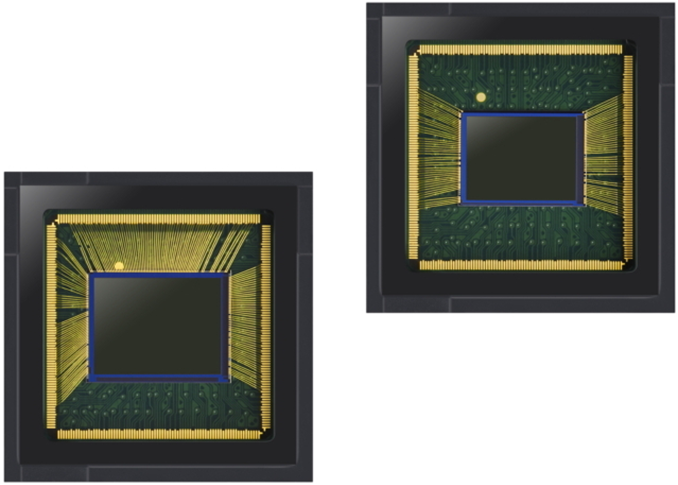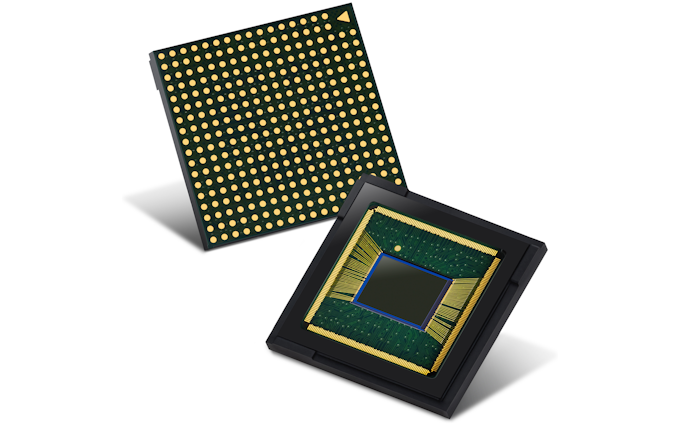Samsung Unveils 64 MP & 48 MP ISOCELL Bright Image Sensors for Smartphones
by Anton Shilov on May 9, 2019 12:00 PM EST- Posted in
- Smartphones
- Digital Camera
- Samsung
- Mobile

Samsung has introduced two new 0.8-μm image sensors for use in upcoming smartphones. The new sensors are the 48 MP ISOCELL Bright GM2 for advanced handsets as well as the 64 MP ISOCELL Bright GW1 for flagship phones. Both 0.8-μm image sensors not only feature very high resolutions via use of very small pixels, but they support a number of technologies designed to improve image quality.
Samsung’s new flagship 64 MP ISOCELL Bright GW1 0.8 μm image sensor features the industry’s smallest pixel for current smartphone sensors. It also supports the company’s 2x2 pixel-binning Tetracell technology, which merges four pixels into one to produce bright 16 MP photos. The technology explains that the sensor colour filters are actually arranged in a 4x4 subpixel arrangement, meaning chroma resolution is at a native 16MP. Samsung however also is able to support a re-mosaic algorithm to make full 64MP resolution images in bright conditions. Other features of the GW1 include Dual Conversion Gain (DCG) that optimizes its full well capacity (FWC) in well-lit environments, and speedy Super PD phase detection auto-focus technology.
The GW1 also supports a real-time dynamic range of up to 100 dB. Just to put the number in context, the human eye can distinguish hues of around 120 dB (according to Samsung), whereas current-generation sensors are all below this and tend to have highly varied dynamic ranges. (Samsung for its part puts the industry average at 60 dB, though this seems a bit low for high-end sensors)
Meanwhile the 48 MP ISOCELL Bright GM2 sensor has the same feature set as the GW1 (Tetracell, re-mosaic, DCG, and Super PC), but uses a smaller 1/2" sensor, versus the much larger 1/1.72" GW1.
The GW1's large sensor size equals that of Huawei's 40MP sensors designed by Sony. Here a big compromise of the big size is that vendors would either have to drop OIS or implement designs with larger camera bumps in order to accomodate the bigger optics required for the large sensor.
Samsung is sampling its ISOCELL Bright GW1 and GM2 with customers and plans to mass produce them in the second half of the year.
Related Reading:
- The Samsung Galaxy S10+ Snapdragon & Exynos Review: Almost Perfect, Yet So Flawed
- Google Rolls Out Night Sight Tech to Improve Quality of Low-Light Photos
- The Google Pixel 3 Review: The Ultimate Camera Test
- Google Announces Pixel 3a & Pixel 3a XL: Mid-Range Phones With Flagship Camera
- Nokia Launches Nokia 9 PureView at MWC 2019: So I Heard You Like Cameras
- Nokia 9 PureView: Hands On, Impressions, Thoughts
- Moto Z Hasselblad True Zoom Mod: Camera Shootout
Source: Samsung











17 Comments
View All Comments
peevee - Thursday, May 9, 2019 - link
"The technology explains that the sensor colour filters are actually arranged in a 4x4 subpixel arrangement, meaning chroma resolution is at a native 16MP"So it is useless.
PeachNCream - Thursday, May 9, 2019 - link
Confirmed. Nothing to see here. Move along.saratoga4 - Thursday, May 9, 2019 - link
That is a typo. 64 MP with 16 MP chroma resolution means a 2x2 standard Bayer filter arrangement, the same as 99.99% of sensors out there. If you click through to the link, the Samsung press release explains this in more detail.BedfordTim - Friday, May 10, 2019 - link
Looking at Honor's comments about the GM1 and other articles it appears that these are actually 12 and 16MP sensors with a software interpolated higher resolution. Samsung state "Tetracell uses a re-mosaic algorithm to produce full resolution images."saratoga4 - Friday, May 10, 2019 - link
All image sensors use a 2x2 mosaic which is interpolated up to the full resolution. See: https://en.wikipedia.org/wiki/DebayeringTetracell is no different than anything else.
BedfordTim - Friday, May 10, 2019 - link
The Honor post suggests otherwise. Honor use both the Sony and Samsung 48MP sensors and they were explaining why they charge more for the Sony version. Samsung's wording also would not make sense if it was a big standard sensor.BedfordTim - Friday, May 10, 2019 - link
Edit. bog not big.saratoga4 - Saturday, May 11, 2019 - link
You're just misunderstanding how debayering works.Skeptical123 - Saturday, May 11, 2019 - link
source at the very bottom "**Tetracell technology merges four pixels into one so that users can achieve high quality images in all light conditions." (2x2 = 4, 4x4 =16) The press release on Samsung's site also says"***In bright environments, Tetracell uses a re-mosaic algorithm to produce full resolution images."So Samsung basically shrunk down the pixels to fit more pixels on a phone friendly size chip. In doing so though they killed the low light performance so much that they regroup the pixels in software... Genius! /s... I thought the phone pixels wars ended a few years ago.
saratoga4 - Saturday, May 11, 2019 - link
What you call "regroup the pixels in software" is how virtually every color image sensor made in the last 30 years works. Don't be confused by Samsung's marketing. This is a conventional image sensor, same as the one in your current phone, just with slightly smaller pixels.